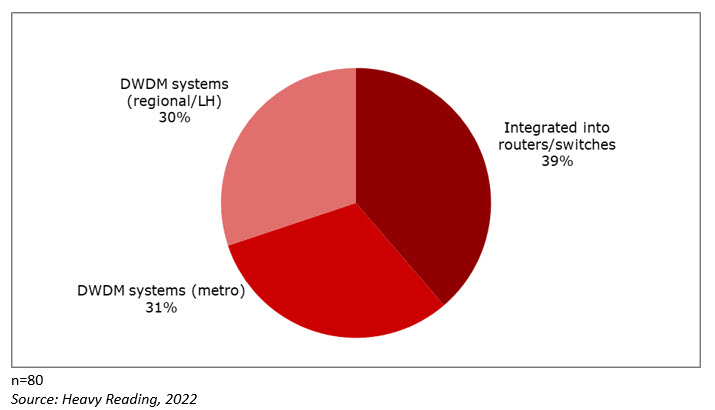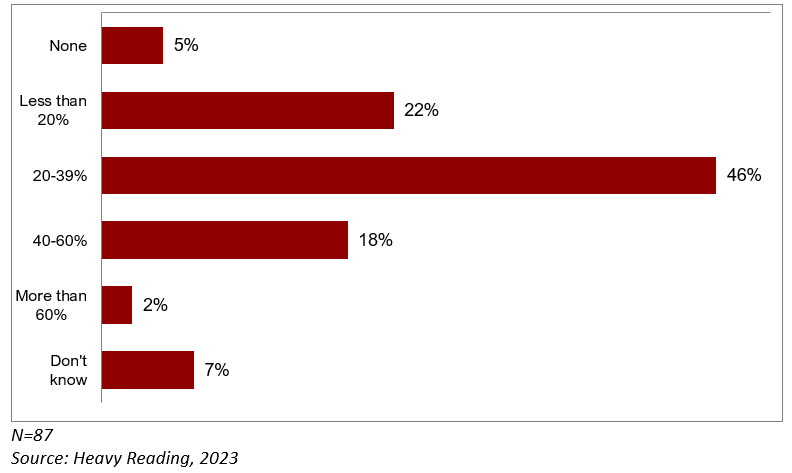Heavy Reading’s Sterling Perrin talks about the new era of IP and optical convergence. What is different this time around? And how can hardware convergence, multi-layer software coordination and the combination of both lead to networks that are more scalable, flexible, efficient and reliable?
The term “IP and optical convergence” means different things to different operators. At the one end is the physical convergence of functions in which colored optics are placed in the router, eliminating the transponder shelf. This is the IPoDWDM architecture. On the other end is the unification of IP layer and optical layer control and management functions such that elements remain physically separate but are managed and controlled as one. An operator’s convergence strategy will often combine elements of both approaches.
Significantly, IP and optical convergence have made a big comeback over the past couple of years, driven by developments and innovations in both hardware and software. But what is different this time around?
On the hardware side, the elimination of the “faceplate trade-off” has been a major catalyst. Starting with the OIF 400ZR standard, line-side coherent optics are housed in the same form factors as client-side optics — and with similar power profiles. Standards bodies and multi-source agreements (MSAs) driving module interoperability include the Optical Internetworking Forum (OIF), OpenZR+ MSA and Open ROADM MSA, among others. Innovative routing system architecture designs have also emerged for hosting coherent pluggables in routers. For example, modular systems match capacity requirements to system capacity and eliminate inflexible backplanes. Additionally, these systems allow the mixing of coherent pluggable and embedded optics for operators that want to benefit from coherent pluggable optics — but without compromising higher performance where it is important.
On the software side, control and management plane programmability and interoperability are driven by software-defined networking (SDN) and the proliferation of open APIs in transport networks. Major contributors to open transport APIs, open architectures and interop testing include the OIF, Telecom Infra Project (TIP), Open Networking Foundation (ONF) and Internet Engineering Task Force (IETF).
Lastly, but perhaps most importantly, network operators really want — and expect — IP and optical convergence to happen. Heavy Reading data consistently reinforces this point. In a 2022 Heavy Reading global operator survey, 39% of respondents reported they expect to deploy 400G+ coherent pluggable optics in their switches/routers (e.g., IPoDWDM or coherent routing).
Figure 1: By the end of 2024, how do you see the distribution of 400G+ coherent optics in your network for various applications?

Physical convergence: TCO benefits
Cost and power savings are among the primary benefits of the physical convergence of coherent optics on IP routers. Physical integration removes transponder shelves from the network, along with back-to-back client optics connecting shelves to routers. This directly results in capex and power (opex) savings that are easy to measure. At 46%, a plurality of operators surveyed in 2023 by Heavy Reading anticipates 20–39% total cost of ownership (TCO) savings by converging coherent pluggable optics on routers. In contrast, 21% expect higher TCO savings among those with traditional transponder-based architectures.
Figure 2: What level of TCO savings (capex + opex) do you anticipate by converging 400G coherent pluggable optics onto routers when compared to traditional transponder-based architectures?

Surprisingly, real-world data shared from early communications service provider (CSP) adopters of coherent routing point to TCO savings well beyond what most operators expect. One CSP reports a 64% reduction in capex and a 76% decrease in opex with the converged architecture. Another CSP reports a 70% reduction in its backbone capex.
Lowering the cost per bit for transport goes right to the bottom line and is a major motivation for operators on its own. Increasingly, however, there is also a sustainability component in network architecture decisions spurred by corporate and even government mandates. Initiatives to reduce footprint and lower power consumption promote sustainability in transport.
Beyond TCO: Benefits of IP and optical layer coordination
Capex and opex reduction benefits receive the most attention in IP and optical convergence, in part because these are easily measurable outcomes to make a business case. But other benefits rate highly too, and sometimes even above TCO savings. Many of these additional benefits come from control and management plane convergence between IP and optical layers and often involve automation. This is the software side of the IP and optical convergence equation. Big benefits that result from tight IP and optical layer coordination and multi-layer interoperability include the following:
- Improved network efficiency and operational simplification
- Greater path diversity across IP and optical layers, boosting reliability
- Greater agility and speed in delivering network services
- Predictive and proactive network operation through machine learning and automation
Future directions
The promise of the new era of IP and optical convergence is more alluring than ever, and early commercial deployments are meeting and exceeding expectations. But viable industry roadmaps and openness are essential for broad global adoption across CSPs. Even early operator networks that are single vendor — such as coherent pluggables and routers from the same supplier — are moving forward under the expectation of a viable multi-vendor future. This includes multiple vendors in IP and optical hardware and in software (i.e., open APIs). Here, operators will rely on industry groups, including the OIF, TIP, ONF and IETF, and on their suppliers to fully adopt the standards produced.
IP and optical control and management plane convergence and physical convergence will lead to new network architectures and improvements in transport that have yet to be envisioned. Ultimately, IP and optical convergence is not just a new way of doing the same. CSPs — together with suppliers and industry groups — have a real opportunity to use IP and optical convergence as a new foundation on which to innovate. The time to get started on convergence is now.






